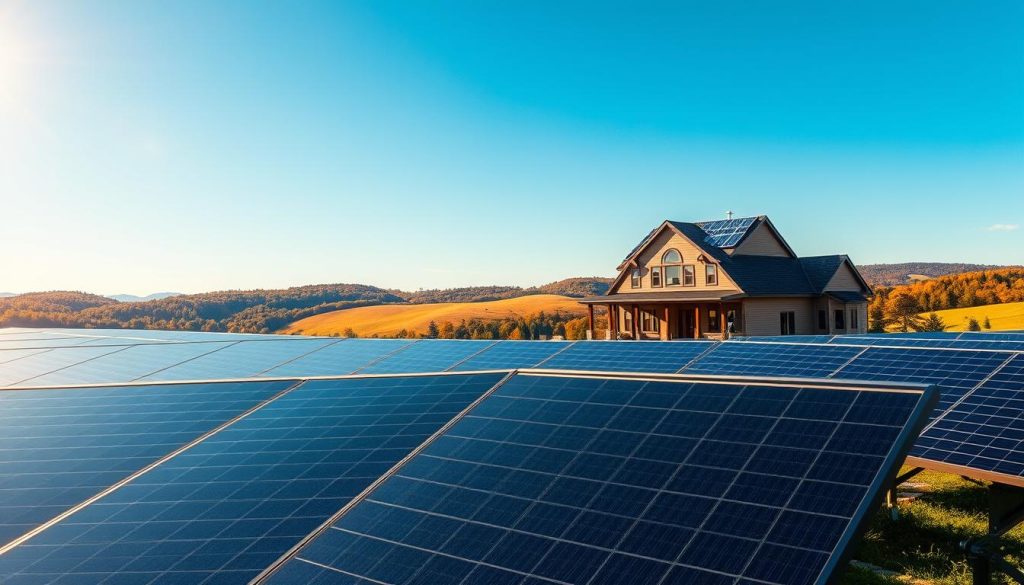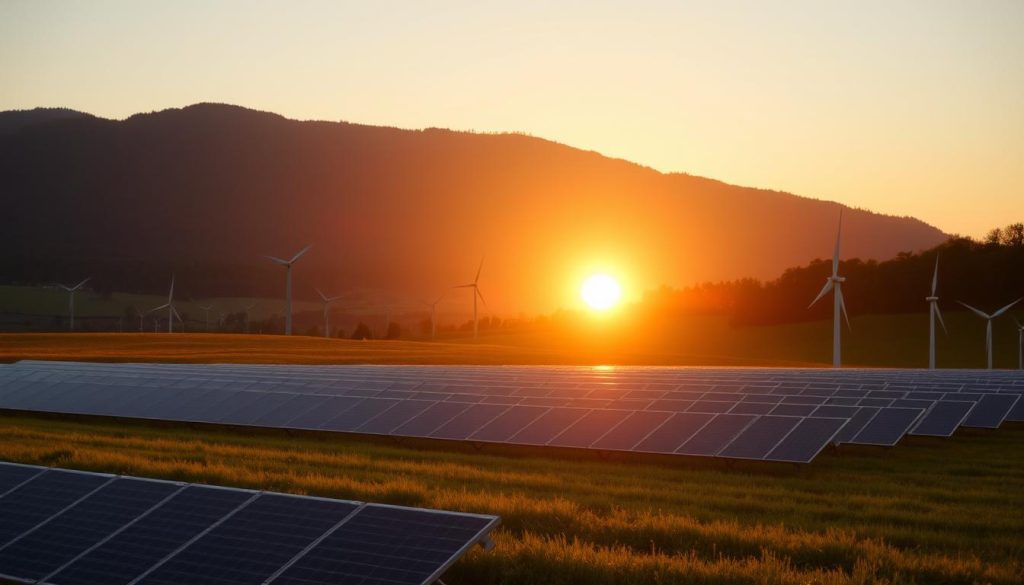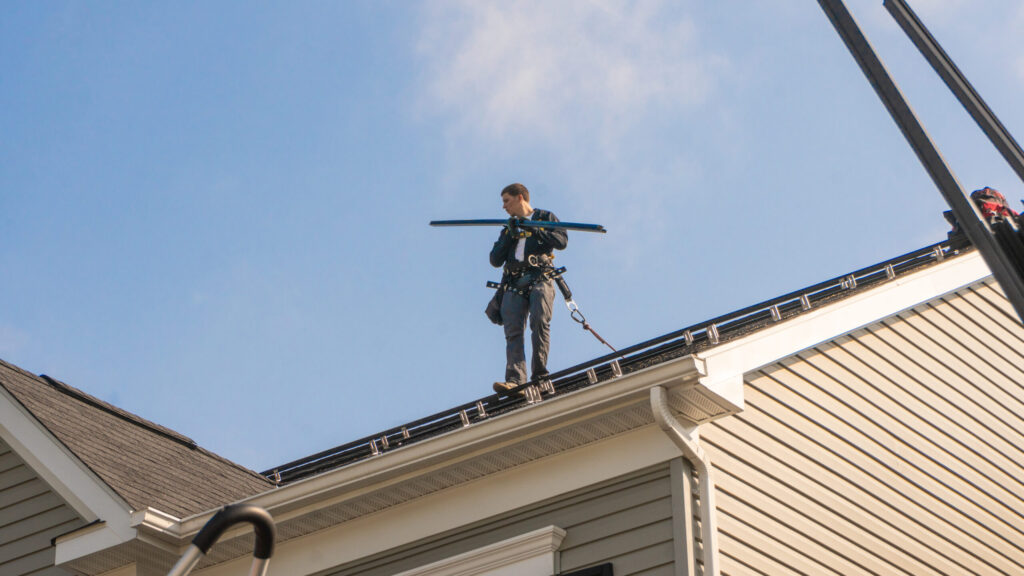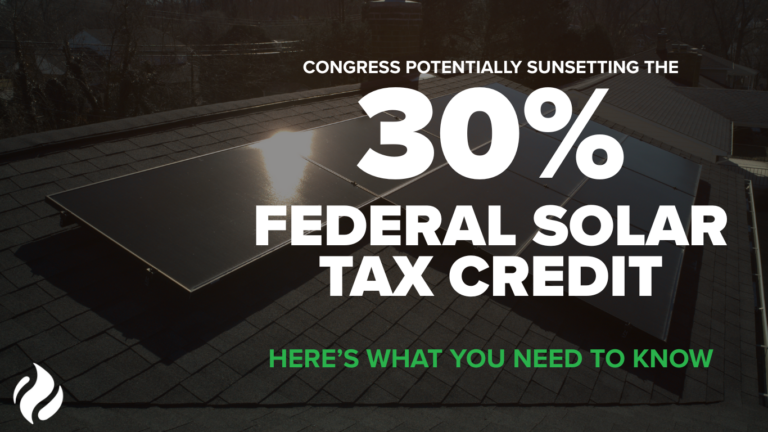Top Solar Panel Solutions in PA
Have you ever felt overwhelmed by rising energy costs and wished there was a way to both save money and protect the environment?
For more information – Click Here
Are you a homeowner in Pennsylvania looking to reduce your energy bills and make a positive environmental impact? You’re not alone. More residents are turning to renewable energy solutions to achieve these goals. This guide will walk you through the benefits and process of making the switch.

One of the most compelling reasons to invest in solar energy is the potential for significant cost savings. By generating your own power, you can lower your monthly utility bills. Additionally, federal and state incentives, like the tax credit, make the transition more affordable than ever.
Beyond financial benefits, adopting renewable energy helps reduce greenhouse gas emissions. This contributes to a cleaner, healthier environment for future generations. Ready to explore how you can join this growing trend? Let’s dive into the details.
Understanding the Basics of Solar Energy in Pennsylvania
Curious about how renewable energy works in Pennsylvania? It all starts with harnessing sunlight and converting it into usable power. This process is both simple and fascinating, making it an excellent option for homeowners looking to save on energy costs.
Photovoltaic systems, often referred to as PV systems, are the heart of this technology. These systems capture sunlight and transform it into electricity. Even in colder climates like Pennsylvania, these systems remain highly efficient. Data from the U.S. Department of Energy shows that solar efficiency can be maintained year-round, even during winter months.

Understanding key terms is essential. For example, power refers to the electricity generated, while energy is the capacity to do work. Additionally, federal incentives like the credit system can significantly reduce installation costs, making the switch more affordable.
Pennsylvania’s average of 4-4.5 daily sunlight hours ensures consistent solar performance. Even on cloudy days, these systems can produce 10-25% of their rated capacity. This reliability makes renewable energy a smart choice for homeowners across the state.
Solar Panel PA: A Comprehensive Overview
Thinking about upgrading your home’s energy setup in Pennsylvania? A well-planned renewable energy system can transform the way you power your space. Not only does it reduce your reliance on traditional energy sources, but it also offers significant cost savings and environmental benefits.
One of the key advantages is the ability to generate your own electricity. This means lower monthly utility bills and greater energy independence. Additionally, federal and state incentives, like the tax credit, make the transition more affordable than ever.
Pennsylvania’s regulatory framework supports the adoption of renewable energy. Programs like net metering allow you to earn credits for excess energy sent back to the grid. This ensures your system remains cost-effective and efficient year-round.
Investing in a renewable energy system also has a positive environmental impact. By reducing greenhouse gas emissions, you contribute to a cleaner, healthier planet. This makes it a smart choice for both your home and the state.
With the right planning, your home can become a model of energy efficiency. From understanding tax implications to leveraging state-specific incentives, the process is straightforward and rewarding. Ready to take the next step? Let’s explore how you can make the switch seamlessly.
Assessing Your Home’s Solar Potential
Wondering if your home is a good fit for renewable energy? Start by evaluating key factors. Your roof’s condition, orientation, and sunlight exposure are critical. A south-facing roof with minimal shading is ideal for maximizing energy production.
Next, calculate your home’s electricity needs. This helps determine the size of the system required. Tools like Google’s Project Sunroof can provide estimates based on your location and energy consumption.
Choosing the right installer is equally important. Look for experienced professionals who can assess your home’s unique needs. They’ll ensure your system is designed for maximum efficiency and long-term savings.
Don’t forget to explore available incentives. Federal and state programs, like the Investment Tax Credit, can significantly reduce upfront costs. Local utility companies may also offer additional perks for adopting clean energy.
Finally, consider your home’s design and local installation requirements. Factors like roof material, age, and obstructions can impact system placement. Balancing these technical needs with your home’s aesthetics ensures a seamless integration.
By taking these steps, you’ll be well on your way to harnessing clean energy and enjoying significant savings. Ready to get started? Let’s make your home a model of efficiency.
Navigating Federal and State Solar Incentives
Ready to unlock savings while contributing to a greener future? Federal and state incentives make it easier than ever to adopt renewable energy. These programs are designed to reduce upfront costs and maximize long-term benefits.
One of the most significant incentives is the federal Solar Investment Tax Credit (ITC). This program allows you to deduct 30% of your system’s cost from your federal taxes. For example, a $13,550 system could save you $4,065. This credit is available through 2032, making now the perfect time to act.
Pennsylvania also offers its own programs to encourage clean energy adoption. Net metering allows you to earn credits for excess energy sent back to the grid. These credits can offset future utility bills, ensuring your system remains cost-effective year-round.
Choosing a qualified solar installer is crucial. They’ll ensure your system meets all federal and state requirements, maximizing your eligibility for incentives. A professional can also assess your roof’s capacity and design a system that integrates seamlessly with the grid.
Don’t overlook local utility programs either. Many offer rebates or grants to further reduce costs. For instance, the Philadelphia Solar Rebate Program provides $0.20 per watt for residential projects, up to $100,000.
By leveraging these incentives, you can significantly lower your investment while enjoying the benefits of clean energy. Start exploring your options today and take the first step toward a sustainable future.
Financing Options for Your Solar Energy Investment
Exploring ways to fund your renewable energy project? Let’s break down your options. Financing your clean energy setup doesn’t have to be overwhelming. With the right guide, you can choose a plan that fits your budget and goals.
One popular choice is paying upfront. This method avoids interest and maximizes long-term savings. However, not everyone has the cash on hand. That’s where loans come in. Secured loans often have lower interest rates, making them a smart option for many homeowners.
Leasing is another flexible choice. It allows you to install a system with little to no upfront cost. While you won’t own the equipment, your monthly bill will likely decrease. Power purchase agreements (PPAs) work similarly, letting you pay for the energy you use at a fixed rate.
Each option has its pros and cons. For example, loans and leases may increase your monthly expenses initially but lead to significant savings over time. A detailed guide can help you compare these methods and decide which aligns with your financial situation.
Don’t forget about incentives. The federal tax credit can reduce your costs by 30%. State programs and local utility rebates may also apply. These perks can make your investment even more affordable.
By understanding your financing choices, you can make a decision that benefits both your wallet and the environment. Ready to take the next step? Start exploring your options today.
Installation Considerations and Best Practices
Are you ready to ensure your renewable energy system is installed for maximum efficiency and savings? Proper installation is key to achieving long-term benefits. Let’s explore the factors that can make or break your project.
Start by evaluating your roof’s condition. A sturdy, well-maintained roof ensures your system’s longevity. South-facing roofs with minimal shading are ideal for maximizing generation. Even in cloudy weather, modern systems can still produce significant energy.
Choosing the right installer is equally important. Verify their certifications and experience to ensure they follow industry standards. A professional will assess your roof’s load capacity and design a system that integrates seamlessly with your home.
Understanding financial implications is crucial. A well-installed system saves you money over time by reducing utility bills. Additionally, explore options like a power purchase agreement to lower upfront costs while still enjoying clean energy benefits.
Weather and panel tilt also play a role. In Pennsylvania, systems are designed to handle varying conditions. Proper angling ensures optimal energy capture, even during winter months. This attention to detail maximizes your system’s performance and savings.
By following these best practices, you’ll ensure your investment delivers the expected returns. From selecting the right location to verifying installer credentials, every step matters. Ready to take the next step toward a more efficient home? Start planning your installation today.
Maximizing Energy Savings and Efficiency
Looking to maximize your energy savings while lowering your utility bills? With the right strategies, you can boost your system’s performance and enjoy significant long-term benefits. Start by leveraging available incentives like the federal tax credit and solar tax credit to reduce your upfront costs.
One effective way to save is by optimizing your energy usage during peak production hours. Running appliances like washing machines or charging electric vehicles between 10 AM and 4 PM can minimize reliance on the grid. This approach ensures you’re making the most of your system’s output.
Regular maintenance is another key factor. Cleaning your panels at least once or twice a year helps maintain their efficiency. Additionally, upgrading to ENERGY STAR-certified appliances can further reduce your electricity consumption, adding to your savings.
Don’t overlook the importance of choosing the right company for your installation. A reputable provider will offer warranties and ensure your system is designed for maximum efficiency. This guarantees long-term performance and peace of mind.
Finally, consider time-of-use (TOU) energy plans. These plans allow you to take advantage of lower rates during off-peak hours, reducing your overall energy price. By combining these strategies, you can achieve optimal savings and efficiency for years to come.
Exploring Alternative Solar Technologies
Are you exploring innovative ways to power your home beyond traditional methods? While photovoltaic panels are popular, there are other solar system options worth considering. These alternatives can diversify your renewable energy portfolio and offer unique benefits.
One such option is solar thermal energy. This technology uses sunlight to heat water or air, which can then be used for heating or electricity generation. It’s particularly efficient for homes with high hot water demands. Another approach is passive solar design, which leverages building materials and orientation to naturally regulate temperature.
When comparing these technologies, efficiency and cost are key factors. Solar thermal systems often have higher upfront costs but can significantly reduce heating bills. Passive designs, on the other hand, require minimal maintenance and no additional equipment, making them a cost-effective option for many customers.
Each solar system has its pros and cons. For example, solar thermal is ideal for specific applications, while passive designs work best in new constructions or major renovations. Understanding these differences helps you choose the right option for your home.
For forward-thinking customers, exploring these alternatives can lead to greater energy independence and sustainability. Whether you’re looking to reduce costs or minimize your environmental impact, there’s a solar system that fits your needs. Start exploring today and take the next step toward a greener future.
Planning and Preparing for Your Solar Journey
Planning your transition to clean energy doesn’t have to be overwhelming. With a structured approach, you can navigate the process smoothly and efficiently. Start by creating a step-by-step plan that covers all the essentials, from reviewing contracts to obtaining permits.
One of the first steps is understanding your purchase agreement. This document outlines the terms of your system’s installation and ownership. Take time to review it carefully, ensuring you’re comfortable with the terms and conditions.
Next, explore power purchase options. These agreements allow you to pay for the energy your system generates, often at a fixed rate. This can be a cost-effective way to adopt clean energy without significant upfront costs.
Don’t forget to factor in federal tax incentives. The Investment Tax Credit (ITC) can reduce your installation costs by up to 30%. This makes your investment more affordable while maximizing long-term savings.
Key preparations include obtaining bids from reputable installers, conducting site assessments, and securing financing approvals. These steps ensure your project stays on track and within budget. A professional inspection of your roof’s condition is also essential to avoid future issues.
By addressing technical and regulatory hurdles early, you’ll streamline your transition to a reliable energy system. Detailed planning ensures you’re fully prepared to enjoy the benefits of clean energy for years to come.
Comparing Solar Options for Your Pennsylvania Home
Deciding to go solar in Pennsylvania involves comparing multiple options to find the best fit for your home. Understanding the cost, installation methods, and financing choices can help you make an informed decision. Let’s break down the key factors to consider.
First, evaluate the overall cost and potential savings. A 5 kW system in Pennsylvania typically costs around $13,550 before incentives. After applying the federal tax credit, your investment drops to $9,485. Over 25 years, this system can save you up to $74,604 on electricity bills.
Next, consider whether to purchase or lease your system. Buying outright maximizes long-term savings, while leasing reduces upfront expenses. For example, a loan for a 5 kW system might cost $85 per month, but you’ll own the system after repayment. Leasing, on the other hand, offers lower monthly payments but no ownership benefits.
Comparing installation options is also crucial. Look for reputable companies that provide warranties and ensure your system is designed for maximum efficiency. A well-installed system not only saves you money but also increases your home’s value.
Finally, think about long-term benefits. Systems with a 25-year lifespan and warranties ensure reliable performance. By choosing the right option, you can enjoy significant savings and contribute to a cleaner environment.
Ready to install solar? Start by gathering multiple quotes to compare prices and services. This approach ensures you get the best deal and a system tailored to your needs. Take the first step toward a sustainable future today.
How to Make a Seamless Transition to Solar Energy
Ready to take the leap into renewable energy and make a lasting impact on your energy costs? Transitioning to a clean energy system is easier than you think. With the right steps, you can ensure a smooth process from start to finish.
Start by coordinating with your local utility. They’ll guide you through the technical integration of your system into the grid. This ensures your setup meets all requirements and operates efficiently. Proper communication with your utility is key to avoiding delays.
Next, review all contractual details carefully. This includes your investment agreement and any permits required. A thorough review helps mitigate risks and ensures you understand the terms. Don’t hesitate to ask questions or seek professional advice.
Align your investment with long-term savings and sustainability goals. Take advantage of federal and state incentives to reduce upfront costs. Programs like net metering allow you to earn credits for excess energy, maximizing your financial benefits.
Finally, ensure every detail is covered, from permits to installation. Work with experienced professionals who can handle the technical aspects while keeping your home’s aesthetics in mind. This approach guarantees a hassle-free transition.
By following these steps, you’ll confidently embark on your pennsylvania solar journey. From coordinating with your utility to reviewing contracts, every detail matters. Start today and enjoy the benefits of clean, efficient energy for years to come.
Conclusion
Switching to clean energy is a smart move for your home and the environment. This guide has walked you through the essentials, from understanding financing options to maximizing efficiency. With federal and state incentives, the purchase of a renewable energy system is more affordable than ever.
Proper planning and research ensure a smooth transition. By evaluating your home’s potential and choosing the right installer, you can enjoy long-term savings and energy independence. The benefits of reducing utility bills and increasing property value make this investment worthwhile.
If you have questions or need assistance, Lumina Solar PA is here to help. Our team can guide you through every step, from initial assessment to installation. Take the next step toward a sustainable future with confidence.
Ready to make the switch? Leverage the insights from this guide and start your journey to clean energy today. Your home and wallet will thank you.



